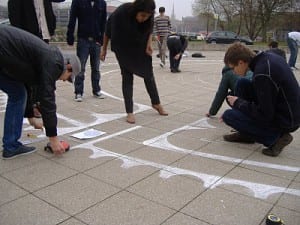Welcome to the Walking the Labyrinth blog hosted by the University of Lincoln. This was created to support the growing interest for the use of labyrinths in teaching and learning in higher education. As well as this home page, the blog has four other areas; Labyrinth projects, Legends, Links and the Gallery. Please explore the contents and feel free to click the Comment link below and make a contribution.
The origin of the labyrinth is shrouded in myth but the symbol appears to have ancient origins and in the 21st centruy people are rediscovering that walking a labyrinths can have many benefits. These include relaxation, stress or anger management, spiritual development, or simply to relax and take a quiet meditative break in the middle of a busy day with time out for oneself.
The use of the labyrinth as a teaching and learning resource has been led by Jan Sellers at the University of Kent, following on from the work of Di Williams at the University of Edinbugh. Jan says “A labyrinth walk or workshop can contribute to modules and programmes and to personal and professional development in a variety of ways, adaptable for students and/or staff. Examples include: creativity (Creative Writing; Dance); reflection (MBA students; strategic planning); exploring values (educational development); reflection on a life journey or on experience and aspirations (any discipline).” Click this link for futher details.
This Walking the Labryinth online information and support network is being developed by Sue Watling, Learning and Teaching Coordinator at the University of Lincoln. For any queries about this area please contact Sue on swatling@lincoln.ac.uk
The banner picture is by Jim Higham and shows the Canterbury Labyrinth in heavy frost at dawn on a crisp winter morning.


